Rediff Business presents the TCS Smart Business Case Study Contest for managers, along with The Smart Manager, the management magazine! We give you a profile and the history of a company. All you have to do is study it and post your solution here, in 500 words or less. The best solution will win a cash prize of Rs 25,000 and a one-year complimentary subscription to India's first world class management magazine! The Smart Manager will also publish the winning solution along with your photograph.
Hurry! The last date to post your solution is March 15, 2007.
Risky business
Risk is central to all business life, but takes on a new dimension in speculative businesses such as stock broking and trading. Trustworthy Securities has extensive, high-tech IT systems in place for risk management and surveillance. Yet will these be enough to tackle the real causes of malpractice? Read on to learn more about fraud in the financial services industry and how to tackle it...
It was a sunny Saturday morning in the heart of India's financial capital, yet there was a frown on Deepak Mehta's face. He was at his desk, in the downtown office of Trustworthy Securities Ltd, one of India's most prominent trading and broking firms.
As the vice president of Risk Management and Surveillance Systems in the head office of the firm, Deepak had just reviewed the statement of "under recoveries" of the past week, and was not impressed with the results. The amount was more than anticipated, resulting in a revision of his funding schedule.
Even more worryingly, this was not an isolated incident, but an increasing trend - the amount of under recoveries was growing every Saturday, and was now too large to be ignored. Extra working capital was needed to make up the shortfall and meet the requirements of the stock exchange. "Enough is enough," he decided. "I will not let this continue". He called a department meeting and assigned his two most promising junior colleagues, Shanti and Praful, to investigate the matter. The crack team got onto the task immediately.
The modus operandi of broking firms
Broking firms have three distribution channels: Internet trading, franchisees and their own branches. They rely heavily on integrated software to manage their operations. When a client trades on the stock exchange via franchisees or branches, she must pay the firm within T+2 days. This is usually in the form of cheques handed over to local staff, who then upload the cheque details into the company's integrated software package. The RMS department receives this payment information, and allows the client to 'carry', or hold, onto her position.
If a given client fails to pay within T+2 days, RMS closes her open position, using its Power of Attorney - RMS has the right to sell the client's position in case of payment default.
Stock exchanges and broking firms
In a modern stock exchange, there are usually three entities: the exchange, the brokers and the investors (clients). In order to trade on the stocks, brokers must deposit a minimum amount with the exchange, a sum known as "margin". Based on this deposit, they are granted permission to trade up to a certain amount, known as their "exposure limit".
A broker cannot exceed his exposure limit unless additional funds are deposited with the exchange. At the end of every trading day, every broker's outstanding dues are calculated, and payment is collected by the exchange on T+2 days, through a system of direct debit from the broker's account.
Whether or not the client has paid the broker is immaterial to the exchange. If the broker fails to maintain a sufficient balance on the scheduled day of payments, he is heavily penalised by the exchange. Thus if the client defaults, the exchange does not lose any money, it is the broker who bears the risk of default.
Enter the RMS department
The RMS department of any broking firm is its watchdog: it is responsible for the firm's solvency, operational efficiency and protection against all sorts of risks inherent to the business of broking (such as market risks, liquidity risks, compliance risk and default risk). It is equipped with state-of-the-art tools and technologies to enable it to be vigilant.
One of these tools is its system of monitoring key information parameters on a real-time basis. These include gross exposures, intra-day trading exposures and the cumulative loss position of each trader and dealer. There is also an audit trail facility for detecting irregularities in scrip price movements. Information on suspended traders, dealers, and/or instruments on participating stock exchanges is immediately shared to prevent price volatility and broker defaults.
The RMS department also has IT systems and packages that monitor trading on a real-time basis to prevent the firm from taking larger than acceptable risk at any point of time. An IT package Saraswati helps to track client positions effectively. Vishwas, a back office system updates compliance information and interacts with all branches and franchisees.
Apart from monitoring, the RMS department plays a key role in managing risk, using varied tools, as follows:
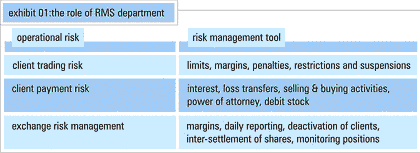
'The cheque is in the post'
When clients fail to pay, the procedure is straightforward: RMS sells their positions, and is empowered to sell any other stocks held in those clients' demat accounts.
Yet the risk management mechanism is not so simple in another instance: when the software says that the cheque has been received, but in actual fact, the cheque does not materialise. The RMS has thus been deceived, and the client benefits by holding on to his stock for a few more days without actually paying for them. His trades are essentially funded by Trustworthy Securities because the exchange debits Trustworthy's account on T+2 days.
This gap between expected cash flow, and actual realized cash flow, puts a heavy burden on working capital requirements, as Trustworthy needs to raise additional funding to pay the exchange. Since additional working capital in the broking business is financed at a very high interest cost, it increases operational expenses and reduces profitability.
The analysis
The crack team, Praful and Shanti, discovered a key insight during their investigations: cheque information was being uploaded to the software, but actual cheques were missing, leading to misinformation across the organization, and a shortfall in collections.
The following data highlights the missing amounts - for example, ten days after trades were conducted on 12th and 14th June, there was an outstanding amount of over Rs 2.1 crores (Rs 21 million) and Rs 1.7 crore (Rs 17 million) respectively.
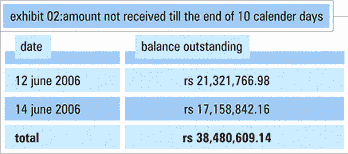
This malpractice was costing Trustworthy Securities at least Rs 20 lakh (Rs 2 million) every year, in extra interest on the additional working capital. (Interest rate of 10 per cent per annum, multiplied by Rs 2 crores (Rs 20 million) extra working capital per working day).
Shanti and Praful were also able to pinpoint details of the clients involved in this deception - as the table below shows, only 300 out of 150,000 were responsible, most of which were located in Mumbai.
The key question was: who was colluding with clients within Trustworthy's fraternity and why?
'Trust me, I'm a salesman'
To understand the problem better, Shanti and Praful investigated the sales and marketing activities of the firm. Like most broking firms, Trustworthy's clients were either managed indirectly by franchisees or directly by branch managers, both of whom reported to relationship managers. Internet customers were directly managed by relationship managers.
It was the duty of the frontline team (franchisees or branch managers) to ensure that cheques were collected and deposited. According to RMS policy, the integrated software should only be uploaded with cheque details when the cheques are actually in hand. So, the question was: who was uploading cheque information without having cheques in hand, and why?
In order to find out, they disguised themselves as summer trainees and visited Trustworthy's branches, pretending to observe daily operations by interviewing people in as informal a way as possible.
Their analysis threw up several possible reasons for systemic fraud: client pressure, breakdown of authority and insufficient monitoring and understanding of the compliance process.
Client pressure and inability to say 'no'
Shanti and Praful's survey of branches and franchisees revealed that the practice of uploading check information, without having checks in hand, was in fact quite common and accepted amongst branch employees. This was justified as excellent customer services, with phrases such "it's a longstanding client relationship", "a high net-worth or credible client", "the client will sell the position tomorrow", "the franchisee will sell the position tomorrow" or "the client has never defaulted."
However, these seemingly harmless phrases disguised the real reason for the deception: to save the branch's preferred customers from having their shares sold by RMS, which is what would happen in the case of non-payments. Thus branch managers chose to deceive the system by entering false check details.
The reason that branch managers wanted to save their clients was one of incentives: the performance appraisal of a branch manager was linked to the amount of the revenue he generated for Trustworthy. Thus, he was not keen to lose clients, and went out his way to cover up their shortfalls in payments. Non-collection was not as important a performance measure as revenue targets.
Lack of command and authority
Another factor facilitating this systemic fraud was the role of 'remisers' - independent individual dealers with their own client base, trading on behalf of clients in order to earn some commission.
The crack team learnt that most of the customers submitting false information were close to the remisers, who themselves were close to franchisees or branch managers. Branch managers were dependent on remisers to attract clientele to the branch, and hence allowed them a level of independence, without closely monitoring their actions. The level of autonomy was so much that some remisers traded using their client's ID and guaranteed their clients a minimum level of return!
These independent dealers had access to the cheque numbers of their client and would thus buy shares on behalf of their clients, and upload these cheque details, without having cheques in hand. The next day, they would sell the stock, delay the deposit or deposit another cheque with different cheque numbers and amount. The entire practice of independent dealers trading on behalf of their clients was going on without written permission or documentation of any kind.
Remisers themselves did not understand the entire back office system. They were unaware of the implications of their action - they did not realise the process by which entering false information resulted in greater need for funds and working capital at Trustworthy's head office.
Systemic loopholes
Shanti and Praful also discovered that branches were ignoring or skimming over outstandings of less than Rs10,000. Information was not entered, or it was insufficient - for example, in one case, the cheque number was just entered as '9'.
This was taking places because the RMS itself was not strict with amounts of less than Rs10,000. While it is a small amount in itself, when multiplied by thousands of amounts across multiple branches, it snowballs into a large sum that is not realised.
Insufficient understanding of compliance systems
Although RMS had sophisticated software systems, the people employed to upload information onto those systems were relatively low-skilled labor, who were easily manipulated by the remisers into entering false information.
A few rotten apples
The good news was that only a few branches had a major problem: the top 10 retail outlets were responsible for almost 90 per cent of the outstanding on any given day.
The solution
Having analysed the situation, the crack team considered their options:
- Imposing heavy penalties on branch managers or franchisees who give misinformation
- Reducing the exposure limits of misbehaving branches and clients
- Creating a back office automated alert system which alerts RMS whenever franchisees or branches sell their clients' positions
- Creating a back office alert system where cheque receipt is delayed, or where actual cheque details are incorrect from the data on the system
- Cheque image upload while punching information
- Blacklist fraudulent clients, with a pop-up alert system when these clients ask for extra limits.
- Charging higher interest for the late payments
- New and innovative payment mechanisms, such as cheque truncation
- Training of branch staff to familiarize them with head office RMS
- Written permission from clients for any trading by remisers
- Incentivising junior employees to be whistle blowers
In the short run, they chose the simplest solution: a penalty. A memo was issued to all branch managers, as follows:

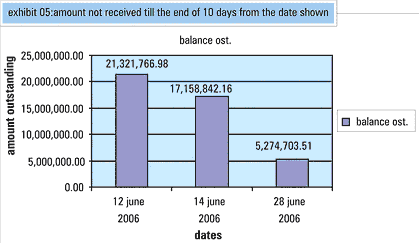
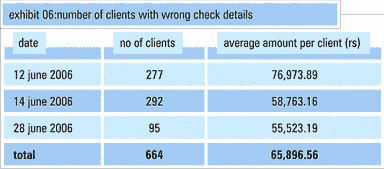
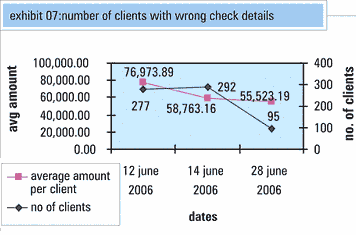
Dear Clients,
A series of serious incidents of false and misleading information has come to be our attention. In order to avoid RMS selling (as per its internal compliance policy for cash and derivatives), some branches are entering incorrect cheque details. Cheques are not being deposited, and in some cases, cheques which are already credited to the client's ledger are given back to save RMS from selling the client's shares.
This is an extremely serious issue. Henceforth, such misleading information will be dealt with seriously. A penalty of Rs1000, or 1 per cent of cheque amount, whichever is higher, per client per instance will be charged for false and misleading information.
We trust you will all cooperate in this matter and avoid such malpractice in the future.
RMS Department
June 22, 2006
The penalty was implemented with immediate effect and paid rich dividends in the days to follow. The crack team followed up individually with branches and franchisees to monitor compliance to the new policy. As a result, the number of cases and amount outstanding reduced drastically, as shown in the following diagrams.
Your challenge:
Deepak Mehta was pleased. His crack team had done a great job and found a quick and effective short term solution. But he was worried over such instances reoccurring in the near future, as he knew that the human mind is ingenious in finding loopholes.
He suspected too that this was an industry-wide problem, as all brokers use similar revenue models and risk management systems. Keen to avoid devoting previous resources to fire-fighting situations, he seeks your suggestions for a long term solution to the problem, without incurring disproportionate additional cost.
The question that you have to answer:
What do you think of some of the team's recommendations and the options in front of them? Which solution(s) would you implement.
Published with the kind permission of The Smart Manager, India's first world class management magazine, available bi-monthly.





